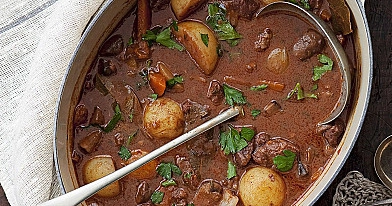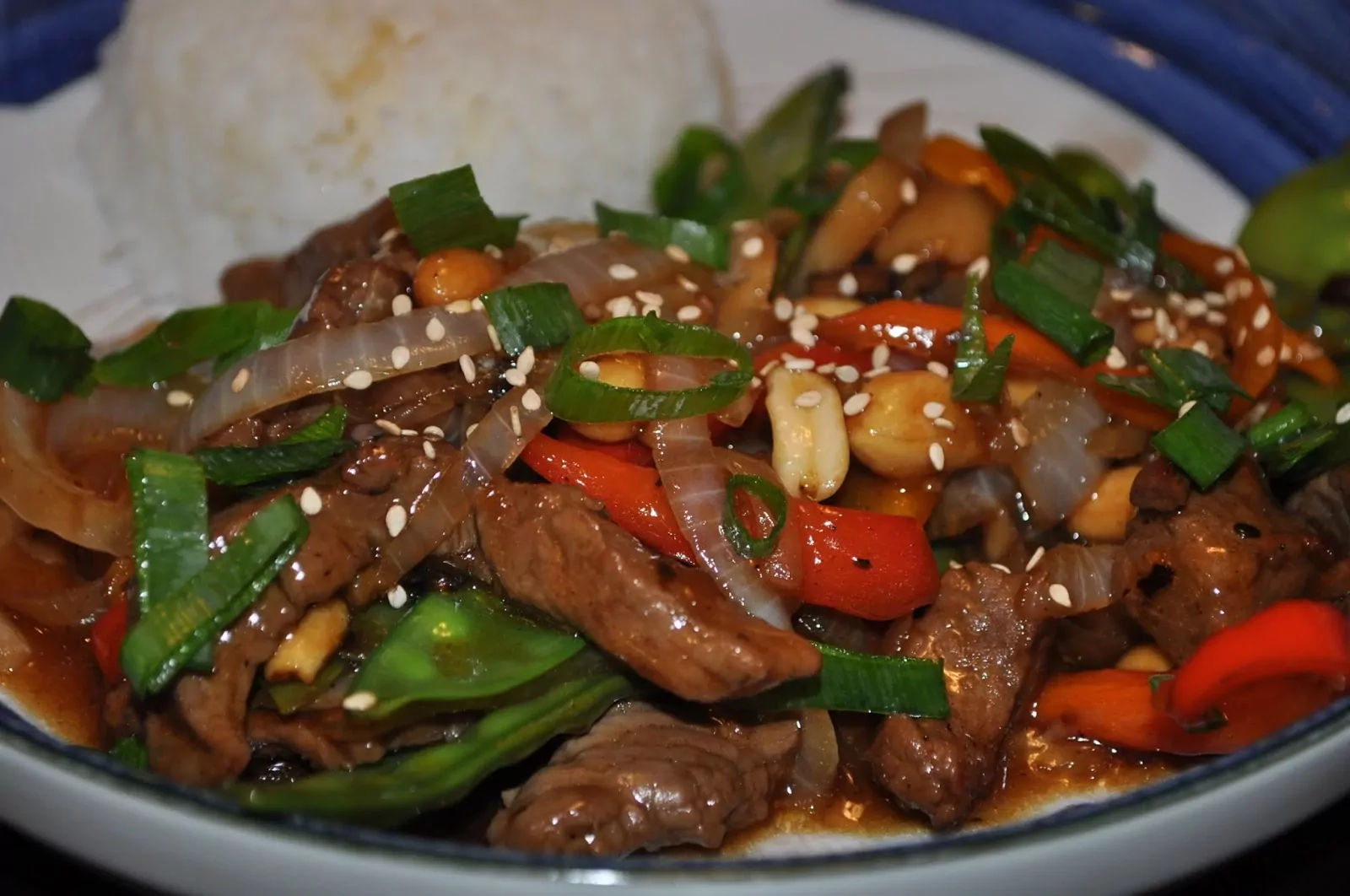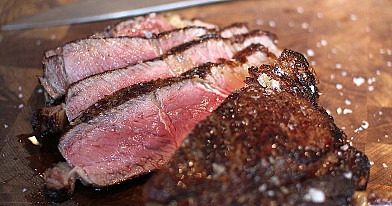
Beef in Chinese: Beef and vegetable stir-fry and teriyaki sauce | Recipe

Beef and vegetable chao (Chinese) or stir-fry is a quick, healthy and delicious dish for the whole family. My own children absolutely love this meat dish made at home. Homemade stir-fry is infinitely more delicious than restaurant stir-fry. The home-made Teriyaki sauce is also incomparably more delicious than any bottled sauce. I highly recommend trying this wonderful recipe. I am absolutely certain that it will become your home's new "special" recipe, even when your closest friends drop by.
My own source for this recipe is our family's grandmother, who celebrated her 93rd birthday later this year - Aunt Halina Daugirdienė, author of the cookbook "Taupioji cook", the Daugirdas family culinary virtuoso. Back in 1989, I learnt how to make this dish from her. Back then, I remember very well, it was called 'Uncle Jonas' favourite dish' in our family. Well, these days it is my children's favourite stir-fry.
For this dish, the most suitable is a beef hide or any sirloin (steak) cut into strips about the thickness of a finger. But if you want to save money, you can also use pork or chicken.
The choice of vegetables for this dish is truly endless. I myself often use leftover vegetables that are already in the fridge and need to be 'rescued' from getting old. Usually it's onions and carrots that have started to soften, peppers that have started to wrinkle, beans that are drying out, or broccoli florets that are beginning to open. I always have nuts (peanuts, curry or sesame seeds) and canned vegetables (young corn cobs, chestnuts or green beans) in the cupboard when I make this dish - I always stock up on these ingredients ahead of time, because I know that the children will often ask for a stir-fry, and I won't always have the time to search for them in the long shelves of the grocery store.
I always use only very fresh meat in my cooking. When I decide to buy meat for this dish, I always buy one or two fresh vegetables to spice it up. This could be, for example, green onion leaves, soft peas (snow pea), any mushrooms I like, or any of the above vegetables - whatever is available at the time in the shop where I shop. The more colourful the vegetables used, the tastier the dish becomes. A minimum of 3 types of vegetables should be available.
The essence of this Chinese beef recipe is that all the ingredients are not braised, but fried in very hot oil in a deep, semi-circular Asian-style stir-fry pan (a heavy-bottomed, smooth-bottomed pan will also do). The flame under the pan shall be above medium, almost maximum.
If at any point during the frying process the pan has become full of black particles, remove them and clean the pan with a paper towel. Add a small amount of oil again and continue your frying.
By the time the stir-fry ingredients have been frying in the pan, the homemade Teriyaki sauce should be bubbling in a small pot nearby. I myself am already a "stickler" and can look after both parts of the dish at the same time, so that at the end the two hot things come together perfectly to make an incredibly tasty dish. But if you are making this dish for the first time, I recommend making the Teriyaki sauce in advance, so that you don't have to stress about it afterwards. With experience in making this dish will come dexterity, and after trying the recipe a few times, you will already know your favourite ingredients for this dish and you will be able to indulge your culinary creativity.
Traditionally, beef and vegetable stir-fry is served with boiled rice or boiled rice with egg. The whole dinner (meat and vegetables, rice, sauce) is prepared at once in about half an hour
You will need a stir-fry or a deep, smooth-bottomed, spit-style frying pan, one ladle for draining the wet vegetables, another ladle and a bowl for the fried ingredients, a pair of tongs or a colander for stirring and scooping out the ingredients, and a one-litre or slightly larger pot for cooking the 'Teriyaki' sauce. The yield is approximately 4-8 servings, depending on the variety and quantity of vegetables chosen.
My own source for this recipe is our family's grandmother, who celebrated her 93rd birthday later this year - Aunt Halina Daugirdienė, author of the cookbook "Taupioji cook", the Daugirdas family culinary virtuoso. Back in 1989, I learnt how to make this dish from her. Back then, I remember very well, it was called 'Uncle Jonas' favourite dish' in our family. Well, these days it is my children's favourite stir-fry.
For this dish, the most suitable is a beef hide or any sirloin (steak) cut into strips about the thickness of a finger. But if you want to save money, you can also use pork or chicken.
The choice of vegetables for this dish is truly endless. I myself often use leftover vegetables that are already in the fridge and need to be 'rescued' from getting old. Usually it's onions and carrots that have started to soften, peppers that have started to wrinkle, beans that are drying out, or broccoli florets that are beginning to open. I always have nuts (peanuts, curry or sesame seeds) and canned vegetables (young corn cobs, chestnuts or green beans) in the cupboard when I make this dish - I always stock up on these ingredients ahead of time, because I know that the children will often ask for a stir-fry, and I won't always have the time to search for them in the long shelves of the grocery store.
I always use only very fresh meat in my cooking. When I decide to buy meat for this dish, I always buy one or two fresh vegetables to spice it up. This could be, for example, green onion leaves, soft peas (snow pea), any mushrooms I like, or any of the above vegetables - whatever is available at the time in the shop where I shop. The more colourful the vegetables used, the tastier the dish becomes. A minimum of 3 types of vegetables should be available.
The essence of this Chinese beef recipe is that all the ingredients are not braised, but fried in very hot oil in a deep, semi-circular Asian-style stir-fry pan (a heavy-bottomed, smooth-bottomed pan will also do). The flame under the pan shall be above medium, almost maximum.
If at any point during the frying process the pan has become full of black particles, remove them and clean the pan with a paper towel. Add a small amount of oil again and continue your frying.
Advertisement
By the time the stir-fry ingredients have been frying in the pan, the homemade Teriyaki sauce should be bubbling in a small pot nearby. I myself am already a "stickler" and can look after both parts of the dish at the same time, so that at the end the two hot things come together perfectly to make an incredibly tasty dish. But if you are making this dish for the first time, I recommend making the Teriyaki sauce in advance, so that you don't have to stress about it afterwards. With experience in making this dish will come dexterity, and after trying the recipe a few times, you will already know your favourite ingredients for this dish and you will be able to indulge your culinary creativity.
Traditionally, beef and vegetable stir-fry is served with boiled rice or boiled rice with egg. The whole dinner (meat and vegetables, rice, sauce) is prepared at once in about half an hour
Advertisement
You will need a stir-fry or a deep, smooth-bottomed, spit-style frying pan, one ladle for draining the wet vegetables, another ladle and a bowl for the fried ingredients, a pair of tongs or a colander for stirring and scooping out the ingredients, and a one-litre or slightly larger pot for cooking the 'Teriyaki' sauce. The yield is approximately 4-8 servings, depending on the variety and quantity of vegetables chosen.
Ingredients
- beef hide or sirloin: 500 grams (chicken or pork is also suitable)
- salt: 1 teaspoon
- freshly ground black pepper: 0,5 teaspoon
- dry chilli crystals: 0,5 teaspoon (crushed red pepper)
- olive oil: 50-100 millilitres (or sesame oil)
- curries or peanuts: 50-80 grams (1 large handful)
- turnip onion: 1 large (200 grams)
- carrots: 1-3 (100-200 grams)
- mushrooms: 100 grams (3-5 garlic cloves for seasoning)
- Sweet peppers: 1-2 (or chilli peppers)
- broccoli florets: 200-300 grams
- fresh or canned baby corn cobs: 1 jar - 230 grams
- fresh green peas: ~200-300 grams
- fresh or canned string beans: 200-300 grams
- water chestnuts: 1 jar - 230 grams
- celery stalks: 3-4
- fresh bean sprouts: ~200-300 grams (bean sprout)
- sesame seeds
- black-grain seeds
- green onion leaves
- Ginger: 1 tbsp (fresh or pickled)
- garlic: 4 cloves
- Brown sugar: 3 tablespoons
- Honey: 1 tbsp (or a little more sugar)
- Water: 0,5 glass (100-120 millilitres)
- soy sauce: ~60-100 millilitres (the saltier, the less you need)
- toasted sesame oil: 1 tablespoon (not necessary)
- starch: 1 tbsp (+2-3 tbsp water)
Caramelised vegetables (optional):
Juicy vegetables (optional):
For decoration (optional):
For the Homemade Teriyaki sauce:
- 1. Chinese Beef: Beef and Vegetable Stir-Fry: Prepare all the ingredients we will need for this dish.
- 2. Wash and drain the beef (or other meat of your choice).
- 3. Then cut into strips about 10 centimetres thick, lightly salted and peppered.
- 4. Then cut the vegetables into strips of about one centimetre or into one-bite pieces.
- 5. As I said, choose the vegetables according to your own desires and preferences.
- 6. I love using chestnuts for this dish. If you can find some to buy, be sure to try it.
- 7. Leave the wet ingredients to drain over the sink in a colander.
- 8. I also like to use corn cobs here.
- 9. Heat 50 millilitres of oil in a frying pan over medium heat.
- 10. Step one: First, fry the meat in hot oil. It must be at room temperature, dry and you can use only pepper and salt. Any pre-marinating of the meat will make the meat moist and harden during the baking process, so I do not recommend marinating the meat. The meat should be cooked for about 3-4 minutes, in small batches, in about one layer and without falling apart. If the meat is larger, then cook in two portions.
- 11. Temporarily remove the roasted meat from the pan and place it in a bowl or grater. The juices and oil from the meat will return to the frying pan.
- 12. Step 2: In the oil left over from the meat, stir-fry one or two or all three of the vegetables chosen from the caramelisation list: turnip onion, carrot and/or mushrooms. It is important that the pieces of vegetables go into the pan completely dry. The vegetable pieces must remain firm and at least one side of the vegetable pieces must be browned in the hot oil.
- 13. Bake in a single layer, or in several portions if there are a lot of vegetables. Place the roasted vegetables in the bowl with the roast meat. Just a reminder that the temperature must be high.
- 14. If you use mushrooms, fry them separately as well.
- 15. One more important thing, don't save the oil, you can see how my carrots are cooked. The oil will be drained afterwards.
- 16. Step 3: At this stage, the pan should be almost dry and the caramelised vegetables should be browned. In this step, the nuts will go into the pan. Fry them, stirring, until at least one side is browned. Then arrange the nuts in the bowl with the roasted meat and vegetables.
- 17. Step four: Add a small amount of oil to the pan. Now fry one or two succulent vegetables of your choice (well drained in a colander): these could be peppers, broccoli florets, canned young corn cobs, peas, pulses, kidney beans or chestnuts...
- 18. Season the vegetables lightly with salt and chilli flakes. Stir-fry for about 2-3 minutes until the wet vegetables start to soften.
- 19. Add all the previously fried ingredients to the pan and pour in the hot Teriyaki sauce.
- 20. Bring the dish to the boil while stirring and immediately remove from the heat.
- 21. Serve with cooked rice, sprinkled with sesame seeds or black-eyed peas and finely chopped green onions.
- 22. Native teriyaki sauce: Prepare all the ingredients we will need.
- 23. Grate or chop the ginger and garlic with a knife on a board. You can grind everything in a spice grinder.
- 24. This is how it looks after crushing.
- 25. In a small saucepan, mix all the sauce ingredients except the last one, the starch.
- 26. Place the pot over medium heat and bring the contents to the boil.
- 27. Mix the starch and cold water in a glass. Pour the resulting mixture into the hot sauce stirred with a spoon in a saucepan.
- 28. Simmer for about 2-3 minutes and remove the sauce from the heat.
- 29. Tip: Homemade Teriyaki sauce can be stored and used for up to 2 months in a sterile sealed container in the fridge. Enjoy!
Recipe Directions

